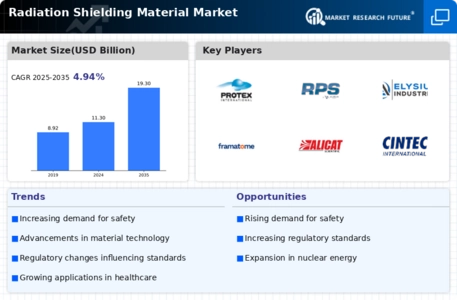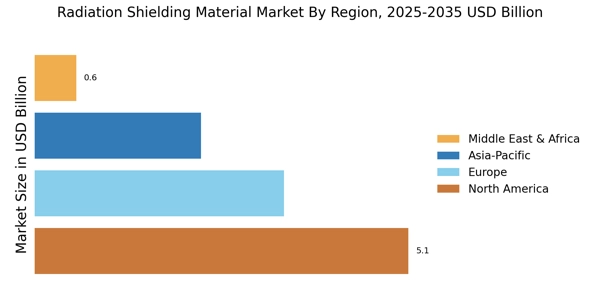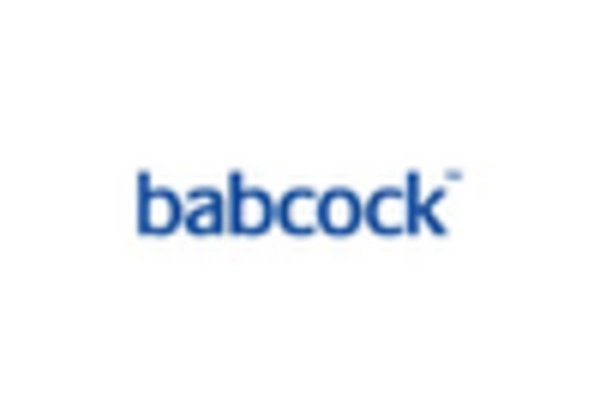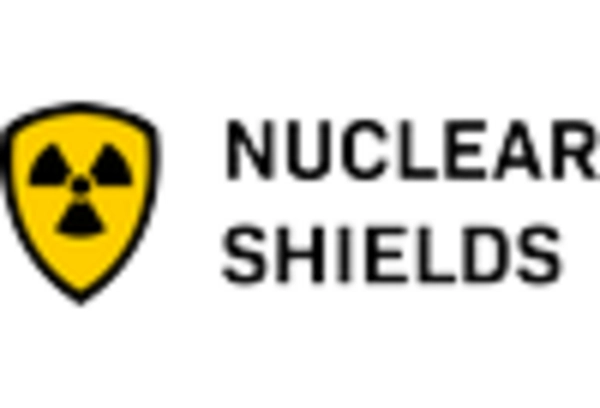Rising Demand from Healthcare Sector
The healthcare sector is a significant driver for the Radiation Shielding Material Market, particularly due to the increasing use of diagnostic imaging technologies such as X-rays and CT scans. As the number of diagnostic procedures rises, so does the need for effective radiation shielding to protect both patients and healthcare professionals. The market for radiation shielding in healthcare is expected to witness substantial growth, with estimates suggesting a potential increase of around 6% annually. This growth is fueled by heightened awareness of radiation exposure risks and the implementation of stringent safety regulations in medical facilities. Consequently, manufacturers are focusing on developing specialized shielding materials tailored for healthcare applications, thereby enhancing their market presence.
Increased Focus on Safety Regulations
The Radiation Shielding Material Market is significantly impacted by the increasing focus on safety regulations across various sectors. Governments and regulatory bodies are implementing stringent guidelines to mitigate radiation exposure risks, particularly in industries such as healthcare, nuclear energy, and manufacturing. This regulatory landscape is driving the demand for compliant radiation shielding materials that meet safety standards. As organizations strive to adhere to these regulations, the market is expected to experience a growth rate of approximately 5.5% over the next few years. Manufacturers are responding by innovating and producing materials that not only comply with regulations but also enhance safety and performance, thus contributing to the overall market expansion.
Expansion of Nuclear Energy Initiatives
The expansion of nuclear energy initiatives is significantly influencing the Radiation Shielding Material Market. As countries seek to diversify their energy sources and reduce carbon emissions, nuclear power is gaining traction as a viable alternative. This shift necessitates the use of effective radiation shielding materials to ensure the safety of both workers and the surrounding environment. The market is projected to benefit from increased investments in nuclear infrastructure, with estimates indicating a potential growth rate of 4.5% in the coming years. As new nuclear plants are constructed and existing facilities are upgraded, the demand for high-quality radiation shielding solutions is likely to rise, thereby bolstering the market.
Technological Advancements in Radiation Shielding Materials
The Radiation Shielding Material Market is experiencing a notable transformation due to rapid technological advancements. Innovations in material science have led to the development of more effective and lightweight shielding materials, such as advanced polymers and composites. These materials not only provide superior protection against various types of radiation but also enhance usability in diverse applications, including medical, nuclear, and aerospace sectors. The market is projected to grow at a compound annual growth rate (CAGR) of approximately 5.2% over the next few years, driven by these advancements. As industries increasingly adopt these new materials, the demand for high-performance radiation shielding solutions is likely to escalate, further propelling the market forward.
Growing Industrial Applications of Radiation Shielding Materials
The Radiation Shielding Material Market is witnessing a surge in demand due to the growing industrial applications of radiation shielding materials. Industries such as aerospace, defense, and manufacturing are increasingly recognizing the importance of radiation protection in their operations. The need for shielding materials is particularly pronounced in environments where radiation exposure is a concern, such as in the production of electronic components and in research facilities. The market is anticipated to grow at a CAGR of around 5% as industries invest in advanced shielding solutions to ensure worker safety and compliance with health regulations. This trend indicates a broader acceptance and integration of radiation shielding materials across various industrial sectors, further driving market growth.


















Leave a Comment